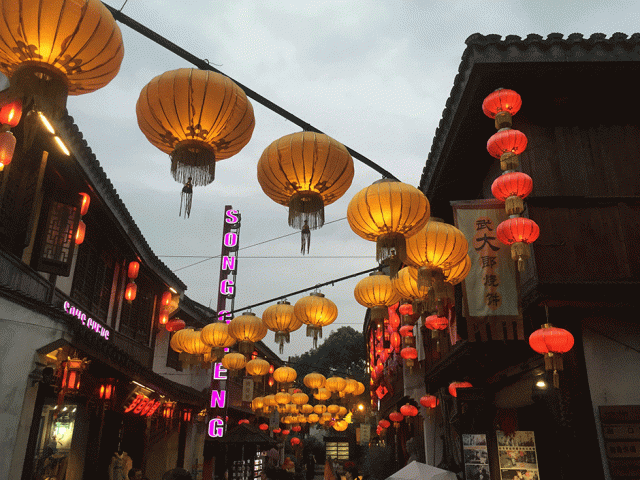China: The great escape
With a history dating back to over 3000 years there aren’t many countries that have as distinct a culture as China

Lanterns line the narrow winding streets of Hangzou's Songchen Park. PHOTO: IBRIZ SHEIKH
Beijing
As the capital city and political centre of China, Beijing is a plethora of rich cultural experiences. Upon arrival in Beijing, throngs of people, bustling streets and raging traffic are among the first impressions the city makes. Putting that aside, one can easily become immersed in the vastness of what the capital city has to offer. From walking the Great Wall and appreciating its magnificent landscape, to delving into the history of the Forbidden City, to unravelling the vibrant city markets, Beijing is truly the gateway to ancient China.
The Greatest wall of all
A trip to Beijing is not complete without a visit to the Great Wall, an incredible structure that has come to be known as China’s most recognisable landmark. One inevitably becomes part of its history while hiking up the high steps or walking down the steep slopes of the wall. One of the wonders of the world, the Great Wall is made up of a series of walls, which were built to protect the Chinese empire from intruders in the 7th Century. Walking from one part of the wall to another, you can reach one of the many station posts where one can take in the spectacular views of the wall, which extends for thousands of miles.

Walking the wall brings with it a surge of emotions, one that may not be easy to pen down, rather something one needs to experience. You sweat, you fall, you stop to take in the breath-taking atmosphere and at the end, there’s no greater joy than saying I walked one of the Seven Wonders of the World.

Forbidden City
Spending a day at the Forbidden City, beyond the gates of Tiananmen (also known as the gate to the heavenly city of peace), one can delve deep into the country’s rich history. The city came into existence in 1406 and has approximately 9,999 rooms that once upon a time housed the emperor’s extensive household and concubines.

Scores of people can be seen making their way into the Forbidden City which in ancient times you would only be able to enter with the emperor’s permission. The cobbled pavements, extensive architecture, the small bridges connecting the city and large sturdy gates give you a true sense of how large the city actually is. Red, yellow, blue and green are used prominently throughout the buildings, all of which hold significant value in Chinese culture.

Temple of Heaven
In ancient China, it was believed that the heavens were circular and the Earth was square in shape. This is depicted in the architecture at the Temple of Heaven, which is circular in shape and four times the size of the Forbidden City.

Cobalt blue, brick red and gold are used extensively on the temple’s exterior, built in 1422. Emperors would make their way to the temple and the Hall of Prayers twice annually to pray for a good harvest.
Shanghai
One of the most popular tourist destinations in China, Shanghai is a cosmopolitan metropolis boasting a population of approximately 25 million. The city represents China in its modern essence. The diversity of the city’s landscape is depicted in its modern skyscrapers and varying architectural styles. The city is split in half by the Huangpu River on either side of which stand remnants of old and new China. From the historic Old Town, to the serene Yu Yuang Gardens, to the futuristic skyline, Shanghai is the city that takes little time to unveil its charm.
The Bund
The heart of the city is framed by The Bund, famous for its waterfront lined by tall buildings. Across the waterfront, modern architecture is visible in the steel skyscrapers and Shanghai’s famed Oriental Pearl TV Tower that lines the skyline.

This part of the city is where you can find the evident contrast between old and modern China. Taking a cruise along the Huangpu River will leave you in awe of the city’s skyline especially when the buildings light up after dusk falls over the city.

Yu Yuang Gardens
In the heart of Old Town, head to the YuYuang Gardens, which makes for a great escape from the hustle and bustle of city life. The garden is among four famous gardens in China and at first glance it is evident why.

The pavilions, ponds and lavish architecture make the garden a breath of fresh air to wander around in and it is here where you catch glimpses of architecture from both the Ming and Qing Dynasties. Old Town and its surrounding areas are a great place to shop for local handicrafts, souvenirs and cheap eats and give tourists a peek into the local culture, especially for budget travelers.

Nanjing Road
One of the world’s busiest pedestrian streets, Nanjing Road is a shopper’s paradise with a history dating back to over 100 years. Shopper’s can pick up a bargain at a local Chinese specialty store or indulge in what international brands and high street stores have to offer.

Come dusk, the popular shopping district paves way for revelers wanting to explore Shanghai’s nightlife. Neon lights, exciting bars and party goers fill the streets post 10pm.

Meijiawu Tea Village, Hangzou
The Meijiawu Tea Village is breath of fresh air and the ultimate haven for tea lovers. Away from the hectic city streets, the tea village is surrounded by lush green mountains and cosy tea houses, with most families running a tea business.

Meijiwu Village produces China’s famed Longjing tea, known for its green colour, strong flavour and refreshing fragrance. The process whereby the plant is picked, dried, fermented and packaged is all performed at the village, much of it being done by hand. Since the time of the emperors, tea has been an integral part of Chinese culture and history.

I left China with a heavy heart, overwhelmed by a country that has experienced rapid growth and change. Their distinguishable culture and unusual lifestyle comes as a culture shock so it’s best to read up on their way of life while planning a trip to China. With centuries of rich history behind it and a bright future to look forward to, China has something to offer everyone. The fascinating people, distinct food, unique sights and smells make China what it is today, an escape from the world as we know it.












1726134115-0/BeFunk_-(41)1726134115-0-208x130.webp)






COMMENTS
Comments are moderated and generally will be posted if they are on-topic and not abusive.
For more information, please see our Comments FAQ